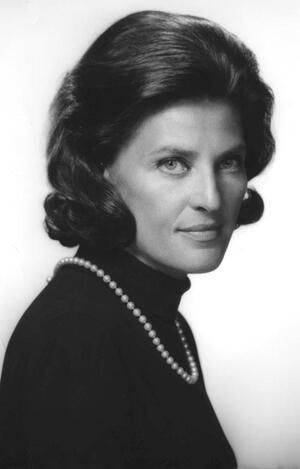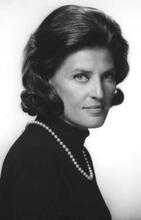Flora Lewis
Called “the world’s greatest correspondent” by New York Times editor A.M. Rosenthal, Flora Lewis covered the defining moments of the twentieth century and became a bureau chief for the Times. Lewis spent three years reporting for the Associated Press in New York and Washington before being assigned to London in 1945; there she met and married reporter Sydney Gruson. Lewis worked for the Washington Post, the International Herald Tribune, and other papers throughout their marriage, finding work in whatever city her husband was assigned—Warsaw, Paris, Jerusalem, Mexico City—until their divorce in 1972. She then became head of the Times’ Paris bureau and first female op–ed columnist. Lewis reported on major international events throughout her extensive career and wrote four books on politics.
Flora Lewis was an American journalist whose insightful reports and commentaries helped explain some of the most significant international events of the second half of the twentieth century to millions of newspaper readers. Over a career that spanned nearly sixty years, Lewis worked for The New York Times, The Washington Post, the International Herald Tribune and other newspapers. Lewis came of age during a time when women’s voices, especially on foreign affairs, were rarely heard in American journalism. She was a trailblazer and a role model for an entire generation of women in journalism.
Early Life and Education
Flora Lewis was born in Los Angeles on July 29, 1922, the second of two children born to Benjamin Lewis, a lawyer, and the former Pauline Kallin, a pianist. It was a Term used for ritually untainted food according to the laws of Kashrut (Jewish dietary laws).kosher home where Jewish holidays were observed, one family member recalled, but Lewis retained little attachment to traditional Jewish life in her adulthood. In her dispatches she often showed sympathy for Israel, but also felt free to criticize the Jewish state when she thought its policies were wrongheaded. She titled a 1990 column on Israel “Lament for Jerusalem.” It expressed a sense of disappointment but also of love, especially for the city’s longtime mayor, Teddy Kollek (b. 1911). She wrote: “If there’s a living soul who embodies the city of Jerusalem, it’s Teddy Kollek. This is a lament for the city, and for him, because he has made his life's work trying to revive it, beautify it and bring it harmony.”
“But it has wrenched itself apart in fear, hatred and violence. Not that Teddy weeps; it isn’t his way. He still storms around, tongue-lashing the arrogant and the fanatic, crowing delight at the greenery, the great art and music brought to give warmth to the old stones and the hopes they symbolize.” One friend recalled that for many years Lewis wore a silver teddy bear pendant that Mayor Kollek gave her as a sign of friendship.
Bright and eager to succeed, Flora Lewis graduated from high school at the age of fifteen and three years later from the University of California at Los Angeles. She went on to study at the Columbia University Graduate School of Journalism where she earned a masters of science degree.
Career Achievements
She was hired as a reporter by the Associated Press, the international news agency, in 1942. She reported first from New York and then from Washington until the news agency sent her to London in 1945. It was there that she married Sydney Gruson, a correspondent in the London bureau of The New York Times.
Their marriage, which lasted twenty-seven years (1945–1972) and produced three children, was marked by major news assignments for both of them in such capitals as Paris, Jerusalem, Prague, Warsaw, Geneva, Bonn and Mexico City. The children were born along the way, Kerry Lewis Gruson (b. 1947) in London, Sheila Claire Gruson (1951–1999) in Tel Aviv and Lindsey Gruson (b. 1952) in Mexico City. During those years of reporting and building a family, Gruson and Lewis reported for separate newspapers; the Times had a rule that barred the spouse of a Times reporter from also working for the Times.
Since her husband worked for the more prestigious and better-paying news organization, Lewis essentially had to find a new job in the foreign capitals to which he had been transferred. “I understand it,” she told a friend, “but I don’t like it.” In 1956, for example, when Gruson was the Times correspondent in Warsaw, Lewis found work reporting from Warsaw for The Washington Post. In 1966 she became an international columnist for the Long Island newspaper Newsday. It was not until Gruson and Lewis separated in 1972 that Lewis was hired to work full time for the Times. She became the Times bureau chief in Paris and later the newspaper’s diplomatic correspondent, the second woman to hold the post. A. M. Rosenthal, the Times’s legendary executive editor, once said of her, “Flora is the world’s greatest correspondent.”
Reporters who worked with her remembered her as fiercely competitive, indefatigable and wonderfully connected to those in power, connections she cultivated in years of tough but fair reporting. But there was also a soft side to her. When she was the head of the Times Paris bureau she often gave many of the best stories to younger reporters in the office. “She was not jealous of by-lines,” said one long-time friend. “She cared deeply about what was going on in the world.”
She also cared about people. When one reporter in the bureau had a serious bout with alcoholism, Lewis dedicated herself to helping her keep her job and her life together. “Flora stuck with her and was wonderful to her,” the friend said.
Reporting Legacy
Lewis wrote in a lucid, accessible style that made complex things clear without diluting the nuances that made them complex. And she wrote with a sense of history that few correspondents could match.
“The salient fact about Europe remains the nation-state,” she wrote in 1992 in Europe: The Road to Unity, one of her four books. “There is a sense of shared Europeanness which has waxed and waned in the last two generations, but it is still secondary to the sense of unique nationality which began to arise after the Renaissance and the decline of feudalism.” She added: “It is the same old Europe, and it changes every day.”
Among the stories she covered were the Soviet crackdown on Hungary after its uprising in 1956. She was also there when, in 1989, Communism began to collapse all over Europe. “The new era starts now,” she wrote in the Times in 1990. “The decisions being taken will hold for a long time, perhaps as long as the cold war lasted. This sense of novelty, of the fateful moment with all kinds of uncertain implications, accounts more for the unease, I think, than the behavior of Germany from Bismarck to 1945.”
While Europe was her main theater of reporting, Lewis also made numerous trips to cover the war in Vietnam and covered both the 1948 and 1967 Arab-Israeli wars. One friend spoke about her bravery under fire. “When the bullets came over the King David Hotel, she was the only one left in the lounge. Everyone else was in the basement.”
Lewis had disarming bright blue eyes and could speak comfortably to just about anyone. She was a smoker and a drinker in an era when such habits were signs of confidence and power. She spent most of her life reporting abroad, eventually settling in a spacious apartment in Paris, not far from the French parliament. She divorced Gruson, who died in 1998. Their daughter Sheila Gruson, a sculptor, died in 1999. Their son, Lindsey Gruson, worked for several years as a New York Times reporter and their daughter, Kerry Gruson, was a long-time member of the staff of the Times bureau in Miami, Florida.
Lewis won numerous journalism awards. Honored four times by the Overseas Press Club, she received its lifetime achievement award. The French government awarded her the Cross of the Chevalier of the Legion of Honor, the country’s highest award in peacetime.
She also had a sense of humor. She was once asked how she managed both family and career. “By neglecting both,” she said. She died of cancer in 2002 in Paris at the age of seventy-nine.
Selected Works
Case History of Hope. New York: 1959.
Red Pawn: The Story of Noel Field. New York: 1965.
One of Our H-Bombs is Missing. New York: 1967.
Europe: A Tapestry of Nations. New York: 1987.
Newspaper articles, articles for magazines including The New Yorker and The Economist.
Obituaries in the New York Times, the International Herald Tribune and other papers. Interviews with her son Lindsey Gruson and her friend Phyllis Hirschfeld.




